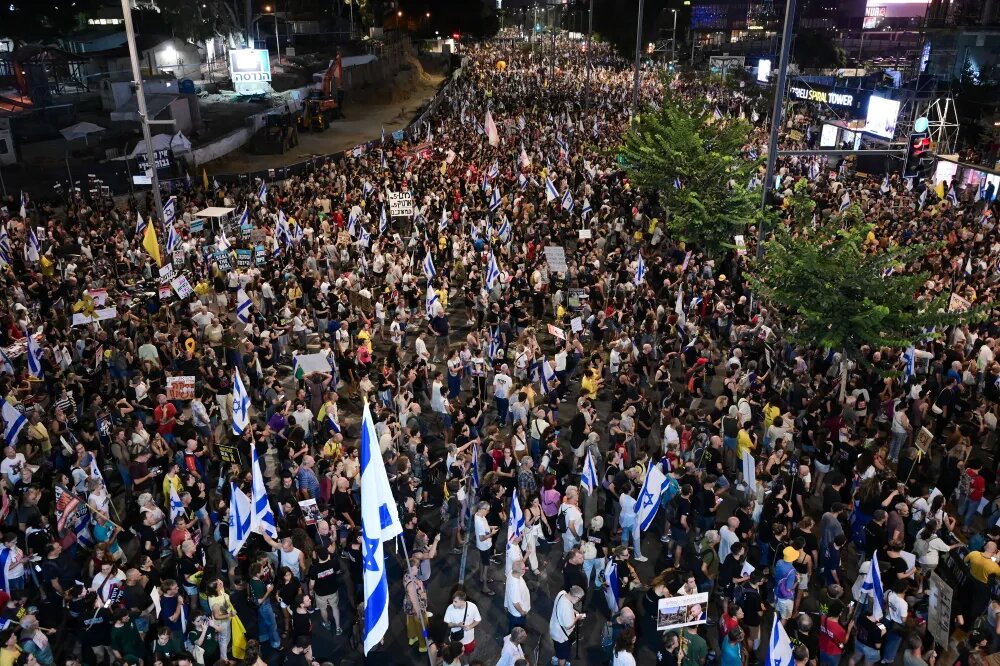Apartheid Regime
An estimated 750,000 people took to the streets across Israel on Saturday night, marking one of the largest demonstrations in the country’s history.
Organizers reported that 500,000 people gathered in Tel Aviv, while around 250,000 more protested in cities such as Jerusalem (Al-Quds) and Haifa.
The protests were largely driven by frustration over the Israeli army’s inability to secure the return of captives still held in Gaza following the conflict that erupted nearly a year ago.
Over 11 months have passed since Prime Minister Benjamin Netanyahu ordered an invasion of Gaza in response to Hamas’s surprise military operation, known as the Al-Aqsa Storm, which took place in southern Israel.
That operation resulted in the deaths of more than 1,100 people and saw around 250 Israelis and foreigners taken captive. To date, approximately 100 captives remain in Gaza, though it is believed that about one-third of them have died.
Israel has managed to secure the release of eight captives and recovered the bodies of dozens. Additionally, over 100 captives were released in a swap deal with Hamas in November last year.
Since the war began on October 7, the Israeli army has not achieved its main objectives, including the elimination of Hamas and the return of all captives. This failure has intensified public pressure on Netanyahu to negotiate a deal with Hamas to secure the remaining captives’ release.
During the weekend protests, demonstrators called for such an agreement. One protester, Efrat Machikawa, a relative of one of the captives, said, “Even those who were hesitant to protest understood that our voices must unite into one huge scream: Bring the hostages back through a deal. Do not risk their lives.”
The protests were marked by clashes and arrests, with demonstrators chanting slogans like “Bibi must go!” and “The regime’s lies won’t bring about security” outside Netanyahu’s residence in Jerusalem.
Protesters also demanded an end to the Gaza war, the collapse of Netanyahu’s government, and a new general strike to intensify economic pressure for a deal.
Netanyahu has faced mounting criticism for allegedly blocking ceasefire negotiations to maintain his hold on power. Many believe that a prolonged state of war benefits him politically, as his government could collapse if the conflict ends and he is held accountable for the failure to prevent the Al-Aqsa Storm Operation.
Recently, Netanyahu rejected a ceasefire proposal put forward by U.S. President Joe Biden and welcomed by Hamas, citing the need for Israeli troops to remain on the Philadelphi Corridor along the Gaza-Egypt border—a major sticking point in the ongoing negotiations with Hamas.
Within Israel, the record turnout at the recent protests suggests that even many of Netanyahu’s supporters are becoming aware of his tactics.
Key Israeli officials, such as War Minister Yoav Gallant and Chief of the General Staff Herzi Halevi, have openly criticized Netanyahu, suggesting he is using the Philadelphi Corridor issue for his political survival.
Internationally, protests have also erupted, calling for an end to Israel’s military actions in Gaza, which have resulted in approximately 41,000 Palestinian deaths.
The strength and resilience of the Palestinian resistance, coupled with the growing divisions within Israel, have increasingly highlighted the regime’s isolation both domestically and globally.
Despite substantial support from the United States and other Western allies, the Israeli military has been unable to achieve its objectives against Hamas, suffering significant setbacks on both the Gaza and West Bank battlefields.
These factors suggest that growing rifts within Israel, combined with the resolve of Palestinian resistance, could ultimately force Israel to withdraw from Gaza.


